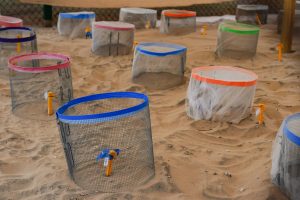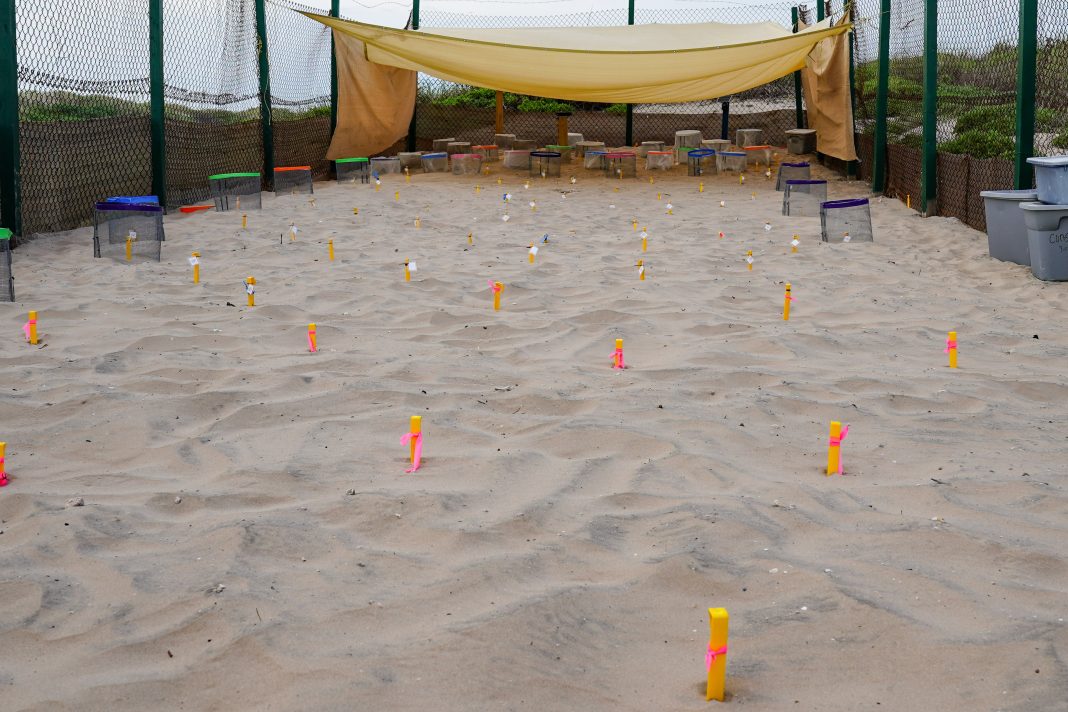|
Only have a minute? Listen instead
Getting your Trinity Audio player ready...
|

SOUTH PADRE ISLAND — It is just before 9 a.m. and a breeze sweeps in off the water over the dunes Saturday as Sea Turtle Inc. Chief Conservation Officer Amy Bonka inspects rows of Kemp’s ridley sea turtle egg clutches buried in the sands of the organization’s protective corral.
A stake marks the location of each nest, with those over the halfway mark for incubation covered with a protective wire ring and netting to ward off parasitic flies and keep any recent hatchlings together.
Each nesting season, Sea Turtle Inc. combs the beaches along the South Texas coast— from April into September— with daily foot and ATV patrols to find and protect the nests until the hatchlings can be safely released.
In addition to protecting nests and hatchlings, the nonprofit works to help conservation efforts and rescue, rehabilitate, and release injured sea turtles.
In 2022, the nonprofit reported the largest nesting year in its history, with more than 100 nests, a total of over 10,000 eggs, for a nesting season that usually averages between 70-90 nests.
Chief Executive Officer Wendy Knight reports that, at this time, their nesting totals are similar to the previous year’s time frame—so their team is staying prepared for the possibility that this year could have a similarly large nest count.
On April 11, Sea Turtle Inc. excavated the first of the more than 60 nests, a total of over 6,000 eggs, now in their protective corral.
Over the nesting period, visitors to the Island might get lucky and see a female Kemp’s ridley sea turtle, which is the primary nester for the area and lays its eggs during the daytime, make her journey across the sands to lay her clutch near the dunes.
If visitors encounter a nesting sea turtle, Knight advises that the first step should always be to call their emergency turtle reporting line at (956) 243-4361. Until the team gets there, Knight says reporters should maintain a 20-foot distance and ensure that other people or vehicles don’t get too close.

“She is a turtle on a mission, and if you spook, scare, or startle her—two things will happen. She will either drop the entire clutch, which means all of them are inviable, or she will get scared and go back into the water and not lay them at all,” Knight said.
On Thursday, Sea Turtle Inc. posted on its Facebook page that they are on alert for the first hatching event over the next few days. Sea turtle eggs incubate for 45-55 days before hatching in a frenzy known as a “boil” because the sand seems to bubble.
Once they emerge, visitors to the Island can get a rare chance, when possible, to see a public release of these new lives, which comes by text or social media notice an hour before the scheduled sunrise release. The quick turnaround for releases is due to the 24-hour energy burst the hatchlings receive to reach the sargassum, where they can begin to feed. Any delay can put their survival at risk.
For sea turtle lovers, Knight advises supporting their work through membership, where members receive individual text message notifications for each scheduled release. The nonprofit also posts a public calendar that lists each sea turtle nest in the corral, the laying date, the number of eggs and estimated hatch dates so visitors can plan trips and vacations around a likely hatching date.
For more information, visit www.seaturtleinc.org.




